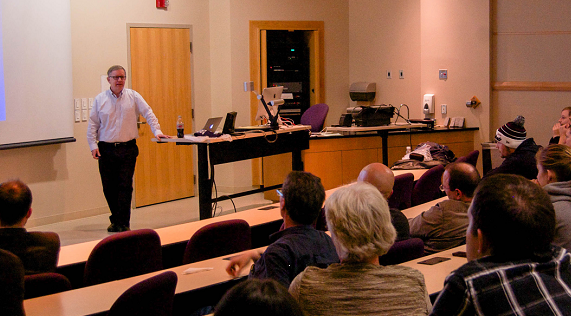Dr. Michael Dorff presents the impact of math in movies
March 5, 2015
Dr. Michael Dorff’s presentation, “Movies and Math: the Past, Present and the Future,” discussed last Friday how math has made an impact on recent animated films.
“Michael is one of the most requested math speakers in the country,” said Dominic Klyve, associate director of the William O. Douglas Honors College and associate professor of mathematics. “He gives several dozen math talks a year all over the United States. So having him here is actually a big coup for Central.”
Dr. Dorff wanted students to see, through this presentation, that math is much more than just adding numbers together, but that math has a lot of different components to it that make it more fun to use.
“It’s cool, too, because if you think ‘of course the most recent computer generated movies look cooler than the ones five or eight years ago’, most people would probably say the reason is computers are now faster,” Klyve said. “But that’s only a really small part of it. Also, the math is much more developed now.”
Disney’s “Frozen” is a movie Dorff spoke of where math played a major role in the development of the film.
Math equations were used to create the different types of snow that are displayed in the movie such as dry snow, powdered snow and chunky snow. The types of math that went into making this happen are topology, linear algebra, multivariable calculus and more.
“[It’s] never been done before in movies. It was just a great technique that they did.” Dorff said.
According to Dorff, creating water flow in movies and being able to make characters move quickly was something that was simply too expensive to do in the past. But there was a breakthrough which allowed for the creation of water flow in animated movies and for characters to move quicker.
“They’re creating new math in order to solve these problems,” Dorff said.
Other examples of math in movies that Dorff referenced were “Star Wars The Empire Strikes Back,” “The Incredibles” and “Brave.” In using a method called the “cage method,” an animated character could be put into a type of virtual “cage” where the character’s arms or legs could be able to be moved through mathematical equations. Dash, a character from “The Incredibles,” was able to make his arms and legs move this way.
With Disney’s “Brave,” Dorff said that mathematical equations went into giving Merida’s hair the ability to move.
“I thought it was really cool to see all the movie animations and think about how math made them happen,” Jean Marie Linhart, math faculty member, said.
Many mathematical equations went into making the animated head of Yoda from “Star Wars” able to move through a method known as “matrix multiplication,” Dorff said. In “The Empire Strikes Back,” Yoda was just a puppet. But in the newer “Star Wars” movies that were released, Yoda was made through animation.
Dorff urged people to think about how they can use math to make something better.
“It’s insightful to see the math behind the animation of movies,” Kirsten Langdale, a chemistry sophomore who attended Dorff’s presentation, said.


